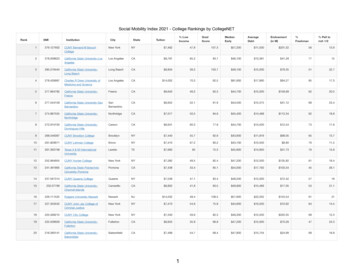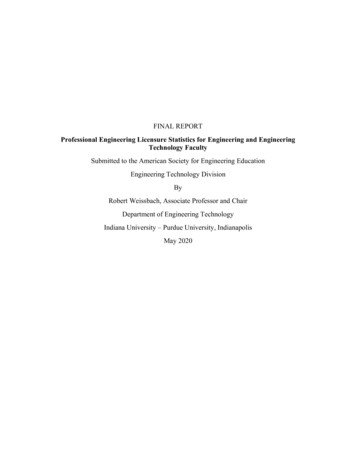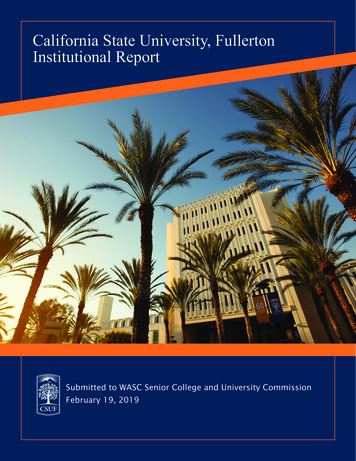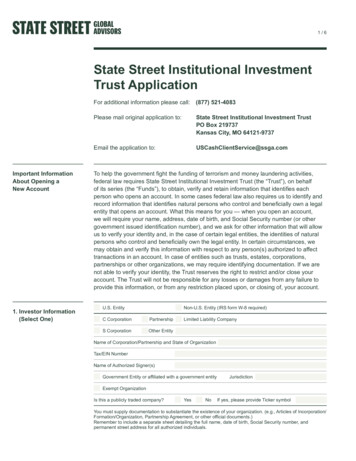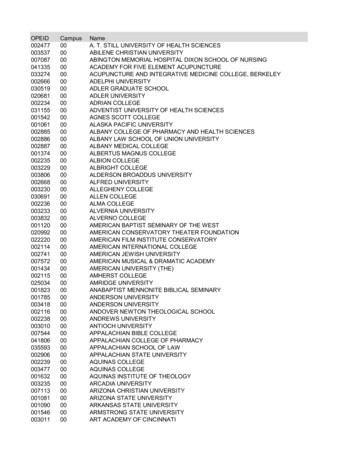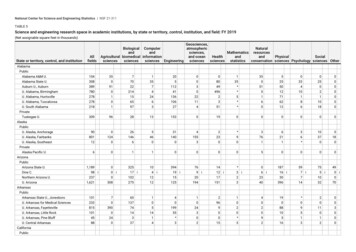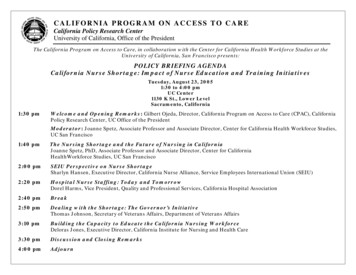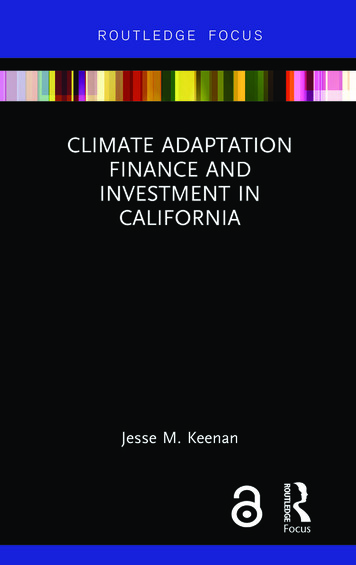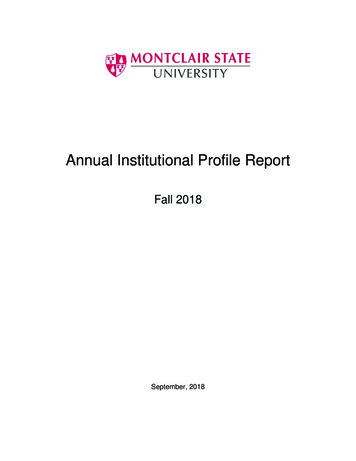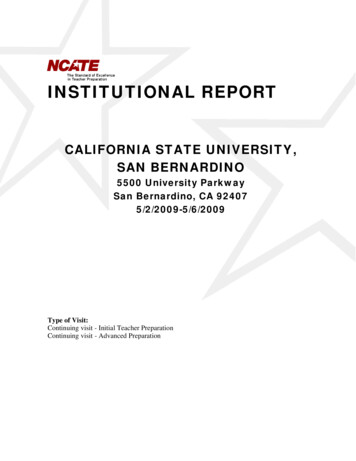
Transcription
INSTITUTIONAL REPORTCALIFORNIA STATE UNIVERSITY,SAN BERNARDINO5500 University ParkwaySan Bernardino, CA 924075/2/2009-5/6/2009Type of Visit:Continuing visit - Initial Teacher PreparationContinuing visit - Advanced Preparation
Page 1Institutional ReportOVERVIEWThis section sets the context for the visit. It should clearly state the mission of the institution. It should also describe the characteristics of the unit and identifyand describe any branch campuses, off-campus sites, alternate route programs, and distance learning programs for professional school personnel.A. Institution1. What is the institution's historical context?Chartered in 1960 by the California Legislature and opened to students in 1965, California State University, San Bernardino (CSUSB) is one of 23 campuses in theCalifornia State University System (CSU), a public, comprehensive university governed by a single Board of Trustees (most are gubernatorial appointments) andserving over 405,000 students supported by 45,000 faculty and staff. It is the second largest public university system in the world. CSUSB’s fall 2007 enrollmentwas 14176 FTES on the main campus and 629 FTES on the Palm Desert campus. Approximately 25 percent of the enrollment is post baccalaureate.2. What is the institution's mission?SummaryThe mission of California State University, San Bernardino is to enhance the intellectual, cultural and personal development of its students. Serving inlandSouthern California, in one of the fastest growing regions in the nation, the University seeks to serve the educational needs of the region and the state by offering awide range of academic programs and support services.California State University, San Bernardino recognizes that one of its strengths is the diversity of the university community. As a result, the University hasdeveloped curricula and services that affirm the multiculturalism of this region and show the dignity and values that unite all people.Faculty, administrators, and staff know, too, that the University serves not just traditional full-time students but others who attend part-time because ofresponsibilities at home and at work. In fact, because many students begin their higher education elsewhere, the University continually updates its transferagreements with surrounding colleges and universities. (Complete Text) http://csusb.edu/president/Vision.html3. What are the institution's characteristics [e.g., control and type of institution such as private, land grant, or HBI; location (e.g., urban, rural, orsuburban area)]?Located in Inland Southern California, about 70 miles east of Los Angeles, San Bernardino and the surrounding region including Riverside County, are among thefastest growing areas of the United States. The population of over 4 million includes 86, 660 residents added from July 2006 – July 2007. The 27,400 square mile,two-county service area is the largest area served by any of the CSU campuses. Figures from 2005 indicate that the median household income in Riverside Countywas 52,029 and in San Bernardino County it was 48,761, compared to the state median income of 49,894 (2004 figure). A broad range of socioeconomic andcultural profiles contributes to the diversity of the region and is reflected in the make-up of its school districts, many of them with Latino populations in excess of50 percent, with a majority of these students being English Learners. The residents of the region are distributed across urban, suburban, rural and isolated desertand mountain communities. San Bernardino County’s Hispanic population size is ranked among the top five in the state. The county is among the leaders inpopulation growth of African Americans among counties with at least 50,000 African Americans. There is a significant and rapidly growing Asian immigrantpopulation.California Post Secondary Education Commission (CPEC) from 2005 indicate a decline in the college going rate in both San Bernardino and Riverside Counties inthe prior two years with both counties falling considerably below the state average of 43.4% and being part of the lower 30 percent of California’s 68 counties.(Data retrieved from CPEC Website, California Context) The region has an ever-increasing population of site-and time-bound students.4. (Optional) Links and key exhibits related to the institutional context could be attached here. (Links with descriptions must be typed into a Worddocument that can be uploaded here. The number of attached exhibits should be limited in number; BOE members can access other exhibits in the unit'selectronic exhibit room.)B. The unit1. How many candidates are enrolled in programs preparing them to work in P-12 schools at the following levels: initial teacher preparation, advancedteacher preparation, and other school professionals?Currently, we have a total enrollment of 1,888 candidates. Eight hundred fifty-three (853) of these are enrolled in initial preparation programs, which is 45% of thetotal enrollment. Six hundred twenty-five (625) are enrolled in advanced preparation programs for teachers, representing 33% of the total. The programs for othereducation professionals enroll 410 candidates, which is 22% of the total, with 12 of those in the education doctoral program. The historical information onprograms tory.pdf, with dates of implementation, is attached. Further details regarding programs are intables 2 and 3 referenced below.1a. (Optional) A table with these data could be attached here. A summary of what the data tell the unit about its candidates should be included in theresponse to B1a above.2. Please complete the following table (Table 1) to indicate the size of the professional education faculty.Table 1Professional Education Faculty and Graduate Teaching Assistants
Page 2Academic RankProfessors# of Faculty who are fulltime in the unit# of faculty who are full-time in # of faculty who are part-time at # of graduate teaching assistantsthe institution, but part-time in the institution & assigned to the teaching or supervising clinicalthe unitunit (e.g., adjunct faculty)practiceTable uploaded inAttachmentsAssociate ProfessorsAssistant ProfessorsInstructorsLecturersOtherTotal2a. (Substitute Table 1) If the titles for academic ranks at your institution do not match the table above, a substitute table reflecting your titles could beattached here.Table 1See Attachments panel below.3. What do the data in above table (Table 1) tell the unit about its faculty?The data in Table 1 indicate that the full time faculty in the unit are primarily at the senior level, most of them tenured. They also indicate that we have a sizablecadre of full time and part time non-tenure track faculty. Of the 82 fulltime faculty in the COE, 57% are full professors; if the faculty who are fulltime in theinstitution but part time in the unit are considered, the figure is 54%. Eighteen percent (18%) are fulltime lecturers who are not on the tenure track. The 134 parttime faculty include clinical supervisors, a number of whom may supervise only two or three candidates in any given quarter due to the large geographical spreadof our field sites. Many part time faculty, as noted in Table 11 http://www.csusb.edu/coe/NCATE/documents/Table11 001.pdf, are clinical faculty with workloadsthat equate to less than one course each. The need for such a large cadre stems in part from the reassigned time used by full time faculty to carry out leadership,service or grant-funded activities. Graduate assistants do not have any teaching or supervisory responsibilities in the unit. The College has been able to hire anumber of faculty in recent years at the associate or full professor levels, so rank does not indicate in all cases longevity. Nevertheless, some retirements will occurover a relatively brief time span or a number of faculty may opt for the Faculty Early Retirement Program (FERP) if it continues to be offered by The CSU.4. Please complete the following table (Table 2) to indicate the programs offered at your institution at the initial teacher preparation level.Table 2Initial Teacher Preparation Programs and Their Review StatusProgram NameAward Level (e.g.,Bachelor's orMaster's)Number ofCandidates Enrolledor AdmittedAgency orAssociationReviewingPrograms (e.g.,State, NAEYC, orBd. of Regents)Program ReportSubmitted forNational Review(Yes/No)State ApprovalStatus (e.g.,approved orprovisional)Status of NationalRecognition ofPrograms byNCATEMultiple gnizedSingle gnizedSpecial cognized5. What do the data in above table (Table 2) tell the unit about its initial teacher preparation programs?We offer the Multiple Subjects (MS), Single Subjects (SS) and Education Specialist (ES) Credentials for the first license to teach. From the data in Table 2, weobserve the following about our three initial programs: The comparative sizes of the programs have not changed recently with multiple subjects having the largestenrollment of the three programs and ES the smallest. The numbers in the MS and SS programs have declined, however, and ES numbers have increased. This isdue in part to the changing population statistics as well as the decision in California not to continue with the class size reduction program. The ES Program, on theother hand, has grown as new approaches to teaching learners with exceptionalities are developed and districts provide more resources for special needs students.The three programs are approved by the State and were recognized by NCATE in 2002, the first time that we sought NCATE review.6. Please complete the following table (Table 3) to indicate the advanced programs offered at your institution for the advanced preparation of licensedteachers and other school professionals.Table 3Advanced Preparation Programs and Their Review StatusProgram NameNumber ofAward Level (e.g.,Candidates EnrolledMaster's or Doctorate)or AdmittedAgency orAssociationReviewingPrograms (e.g.,State, NAEYC, orBd. of Regents)Program ReportSubmitted forNational Review(Yes/No)State ApprovalStatus (e.g.,approved orprovisional)Credential OnlyAdapted P.E.Credential4State WASCBilingual/CrossCulturalMaster's22State WASCCareer &TechnicalMaster's34State WASCCorrectional &AlternativeMaster's3State WASCMaster of Arts inEducationsOptions:YesApprovedStatus of NationalRecognition ofPrograms byNCATE
Page 3EducationCurriculum &InstructionMaster's70State WASCHolistic &IntegrativeMaster's5State WASCInstructionalTechnologyMaster's58State WASCKinesiologyMaster's20State WASCTESOLMaster's45State WASCScience Education Master's15State WASCSpecial Education234State WASCMaster'sEducation1HealthMaster's7State WASCMA in Teaching(Math)Master's12State WASC95State ster's/AdvancedCredential (Tier 1)MA: EducationalAdministration227State lServicesCredential (Tier 2)6State WASCYesApprovedSchool PsychologyCredential/Advanced 42PPS CredentialState WASCYesApprovedSchool counselingPPSCredential/Masterof Science inCounseling &GuidanceCredential/Advanced 123State teWASCReading/LanguageArts SpecialistMaster's/SpecialistCredential/MA inCredentialEducation:Reading/LanguageArtsOther SchoolProfessionals127. What do the data in above table (Table 3) tell the unit about its advanced programs?The unit offers one advanced program for licensed teachers which is a credential only (Adapted Physical Education), nine options within the M.A. in Education,one M.A.T. (math), and a combination M.A. option and credential in reading/language arts. Programs for other school professionals include two master’sdegree/credential combinations (MA in Ed. Admin./Admin. Services) and MS in Counseling and Guidance/School Counseling); the School Psychology Credentialand the Educational Leadership Program (Ed.D.) with a total enrollment of 410 which is 29% of enrollment in the unit. Most candidates who have the option to doso pursue the MA/ or MS/credential combination. This history of our programs, referenced above, is indicative of the changing legislative landscape in Californiathat has required adjustments to credential programs over the years. It also reflects the responsiveness of the Unit faculty in meeting identified educational needs inthe region. The continuing expansion and fine-tuning of M.A. degree options is a clear example of the latter. We are proud to have been in the first group of CSUcampuses authorized to offer the doctorate in educational leadership and to have received approval from WASC to do so. This is yet another example of our abilityto respond to educational needs in the region.8. What programs are offered off-campus or via distance learning technologies? What alternate route programs are offered?The College of Education and the university as a whole are committed to serving the needs of site-and time-bound students. To serve our population effectively, allprograms in the Unit are available after 4:00 in the afternoon to full- and part-time students, and at various times over the years, programs have been available atoff-campus sites edOffCampusorViaDistanceLearningTechnologies.pdf or in a weekend format as needsindicated. Many instructors use Blackboard and similar programs in their courses and are creating hybrid programs with the development of courses that areoffered partially or completely on-line. Three options in the M.A. in Education (Instructional Technology, Career and Technical Education, Reading /LanguageArts) and the Level II Education Specialist Programs were approved by WASC to offer the programs with more than 50% on-line. Most notable among the off-siteofferings are the programs at CSUSB’s Palm Desert Campus http://pdc.csusb.edu/Teacher Education.htm. Established 19 years ago to serve upper division, postbaccalaureate and master’s students, the campus is now in the process of acquiring permanent, privately funded facilities. The Campus currently serves 127.8 fulltime equivalent students (FTES) in professional education programs. In 1999, a second center opened to serve the High Desert communities. Housed on thecampus of Victor Valley College, the program received initial multiple- year funding through a U. S. Department of Education Title V grant for Hispanic-ServingInstitutions (HSIs). Until this year when low enrollments caused them to go on hiatus, the Multiple Subjects Credential and Administrative Services credentialprograms were offered at the site. We do not offer any alternate route programs.9. (Continuing Visit Only) What substantive changes have taken place in the unit since the last visit (e.g., added/dropped programs/degrees; significantincrease/decrease in enrollment; major reorganization of the unit, etc.)? (These change could be compiled from those reported in Part C of theAACTE/NCATE annual reports since the last visit.)As outlined in the attached table veChangesSinceLastVisit 000.pdf, a number of important programmaticand organizational changes have taken place in the unit since the last accreditation. In the College of Education, the Education Specialist Department was dissolvedand the Education Specialist credential coordinator position became a director position in the Division of Teacher Education. An Office of Research andAssessment was created and staff hired, and the student services functions of advising, recruiting and credential processing were merged to create a new StudentServices Office within the Teacher Education Division. New programs include those in Educational Leadership (Ed.D.) and the M.A.in Education Option inCorrectional and Alternative Education. Enhanced programs include the M.A. Core which now has a director, the M.S. in Counseling and Guidance and the M.A.
Page 4Option in Instructional Technology. Four advanced programs for teachers received WASC authorization to offer the programs 50% on line. In the Multiple (MS)and Single Subjects (SS) Programs, candidates now have the option to attend school fulltime and complete a degree and a credential in four years. Finally, inseveral programs through the entire unit, there has been an increased emphasis on assessment and on adapting instruction to meet the needs of all students. This hastaken place in a variety of ways: with specific changes/additions to courses, with modifications at the program level, through faculty research and grants and viaprofessional development opportunities for faculty.Changing staff needs and student populations in the region’s school districts, an increase in the number of institutions offering weekend and “fast track” programsfor credential candidates, class size reduction policies and changes at the state level offering alternative pathways to some credentials have affected enrollmentpatterns in the College of Education during the past decade. These changes have included major spurts in enrollment growth as well as significant downturns insome programs. The enrollment in the College of Education nearly doubled between academic years 1995-1996 and 2000-2001 with the highest percentage ofgrowth occurring in Educational Administration, Elementary Education, Reading Education, and Secondary Education. In the same period, the percent of FTES inthe University represented by Education enrollments climbed from 11.7 % in 1995-96 to 16.1% in 2000-2001. Since the peak year of 2002-03 with 2,209annualized FTES, full-time equivalent enrollment declined slightly in 2003-04 by 5% but most sharply in 2004-05 by 24% from the previous year (due in part to alack of state supported summer session that year). Since that time, the decline has been about 2% per year with a leveling off to where between 2006-07 and 200708 FTES was essentially unchanged. The COE hired a full time recruiter to address the need for more science, math and Education Specialist teachers. Individualprograms have developed systematic recruitment efforts. Increased communication between COE faculty and academic departments with Commission approvedprograms should result in more graduates remaining at CSUSB to pursue a credential.The table provides evidence that faculty and staff in the unit are attuned to the needs of the region that we serve, that we consider feedback from the field whenmaking programmatic decisions, and that we heed the changes envisioned and recommended by our various accrediting bodies to enhance the quality of ourprograms.10. (Optional) Links and key exhibits related to the unit context could be attached here. (Links with descriptions must be typed into a Word documentthat can be uploaded here. The number of attached exhibits should be limited in number; BOE members can access other exhibits in the unit's electronicexhibit room.)CONCEPTUAL FRAMEWORKThis section provides an overview of the unit's conceptual framework(s). The overview should include a brief description of the framework(s) and itsdevelopment.1. Briefly summarize the following elements of the unit's conceptual framework: the vision and mission of the unitphilosophy, purposes, goals, and institutional standards of the unitknowledge bases, including theories, research, the wisdom of practice, and educational policies that drive the work of the unitcandidate proficiencies related to expected knowledge, skills, and professional dispositions, including proficiencies associated with diversity andtechnology, that are aligned with the expectations in professional, state, and institutional standardssummarized description of the unit's assessment systema. the vision and mission of the unitThe College of Education at California State University, San Bernardino (CSUSB), is dedicated to the development and support of wise, reflective teachers andother education professionals with substantial knowledge of their disciplines and dedicated to educating students who will work toward a just and diverse societythat embraces democratic principles. Possessing powerful pedagogical, procedural and practical knowledge, these educators respect a variety of viewpoints andexhibit an ethic of care and concern for their students and professional colleagues. Community members, students and all educators are engaged in a reciprocallearning process. They are, in effect, learners working collaboratively to make sense of the world that surrounds them.The Mission of the College of Education at California State University, San Bernardino is to prepare education and human service professionals for lives ofleadership, service and continual growth through the development of curriculum and programs that transform individuals and the community. Our core beliefs in the dignity and inherent worth of all people, diversity and multiple perspectives as essential, treasured assets, a collaborative teaching/learning community, the crucial leadership role of education professionals in promoting positive social change, fostering human development, achieving social justice, and promotinghuman rightsform the foundation for our work. In collaboration with university and P-12 colleagues, clients, students, alumni and the community-at-large, we apply our valuesand beliefs in responding to evolving needs and priorities in the schools, agencies and communities of the region we serve.Adopted by the College faculty and staff and approved by Dean Patricia Arlin, April 22, 2008 (Complete text of Mission Statementhttp://csusb.edu/coe/mission statement.htm.)b. philosophy, purposes, goals, and institutional standards of the unitThe Conceptual Framework l Framework 001.pdf describes our commitment to a definition of educationas an ongoing developmental process that embraces a core set of principles based on studies of wisdom and exemplary teaching that incorporate, but are not limitedto, national, state and discipline-based educational standards. A commitment to diversity and to preparing professional educators to work with diverse populationsare at the heart of the Institutional Standards, the University Mission and the College of Education Mission as noted throughout our response to each NCATE andCCTC Common Standard.The five characteristics of the wise professional educator outlined below serve as our institutional standards.Wise educators possess rich subject matter knowledge. They have a structural understanding of their discipline’s concepts, procedural knowledge and skills, andunderstand the interactions and place of their discipline within the context of other disciplines and society.Wise educators apply sound judgment to professional practice and conduct. Within their discipline they are able to integrate theory and practice and know how torepresent and explain their discipline in ways that make that subject matter understandable to students, clients, or other adults. Additionally, their actionsdemonstrate a strong commitment to ethical, responsible, and professional behavior.Wise educators apply a practical knowledge of context. They know, understand, and act appropriately related to the specific contexts that result in the implicit
Page 5understandings brought to the educational setting by the learner/client.Wise educators respect multiple viewpoints and priorities of their peers, students, clients and communities. They strive to understand the values of the variousindividuals and groups with whom they interact and make a concerted effort to incorporate knowledge of and sensitivity to those values into all professionaldecisions.Wise educators reflect on their professional practices and follow up with appropriate action. They are comfortable and flexible when making professionaldecisions, drawing on their experiences and knowledge of their students/clients. Using reflective strategies and formal and informal assessments of their work, wiseeducators make necessary adaptations to meet the needs of students/clients.c. knowledge bases, including theories, research, the wisdom of practice, and educational policies that drive the work of the unitCertain developmental and learning theories inform the shared vision of the College and of its various departments and programs. These theories support the viewthat learners, through experience and interaction with others across time, actively construct and reconstruct knowledge in order to create meaning. At the heart ofthe College’s shared vision is the belief that teaching, learning and development are intimately integrated and that university faculty are themselves active learnersalongside students. Developing as a wise professional educator implies a lifelong commitment to continual engagement in the process of teacher/leader as learner.The description of the wise professional educator is grounded in the developmental psychology of wisdom studies; (Baltes and Smith, 1990; Staudinger, Maciel,Smith and Baltes 1998; Baltes and Staudinger, 2000; Baltes and Kunzmann, 2004; GIA1/4ck and Baltes, 2006). The application of these studies contributes to theconcept of the wise teacher (Arlin 1990, 1999) and exemplary teachers (Collison 1996). Recently the discussion has turned to the relationship between intelligenceand wisdom (Sternberg and Jordan, 2006). Brown and Green (2006) describe five key categories in their analysis and one crucial “core” category they name the“learning from life” process. They define this process as “self-knowledge, understanding of others, judgment, knowledge, life skills and willingness to learn.” Inthis tradition the College of Education faculty strive to prepare professional educators who are life-long learners who are constantly engage in “learning from life”,learning from their teaching and from their students and who become wise in the processd. candidate proficiencies related to expected knowledge, skills, and professional dispositions, including proficiencies associated with diversity and technology, thatare aligned with the expectations in professional, state, and institutional standardsThe alignment table posite-AlignmentTable 000.pdf provides the standards alignment for all programswith proficiencies in diversity and technology. The diversity proficiencies ciesRelatedtoDiversity4a1 001.pdf are also listed by program in Standard Four. At the time of the initial NCATE accreditation, the Conceptual Framework was relatively new and notsufficiently infused into courses and programs. The Institutional Standards drawn from the Framework are now evident in course and program design and clearlytied to NCATE standards. Candidate proficiencies are linked to state, NCATE and institutional standards as well as to professional association standards whereapplicable. We can claim that we prepare “wise professional educators” only when our candidates embody the characteristics described in the five tenets of theFramework and demonstrate successfully the proficiencies described in the alignment table and in Standards One and Four.e. summarized description of the unit’s assessment systemThe Unit Assessment System smentsTimeline09.pdf is designed around three components: the ConceptualFramework, including institutional standards; program evaluation; and a program reporting and documentation process. The latter incorporates program evaluationswhich summarize program strengths, areas of need, and use of data for program improvement in Annual Program Reports. All programs are guided by theinstitutional standards which align with program, state and/or national standards. Program faculty review candidate performance data, candidate, alumni andemployer surveys, and advisory group feedback, all of which is summarized in an annual program report. In the annual reports, the specific use and/orimplementation of the data and feedback are explained. Following review of each annual program report by the appropriate associate dean or chair, the associatedeans draft a Unit Assessment Report for review by the Unit Assessment Committee which makes recommendations to be considered at the annual Cabinet Retreat.This facilitates the development of unit goals and informs the allocation of financial and human resources. Program faculty review program reports and unit goalsto establish individual program goals for the ensuing year. The Director of the Office of Research and Assessment also provides trend analysis and other support toprograms. A major strength of the assessment system lies in the involvement of individual faculty members as well as those in leadership positions. By following acarefully constructed calendar and step-by-step process, program and unit improvements are ongoing throughout each academic year.The California Standards for the Teaching Profession (CSTP)http://www.ctc.ca.gov/reports/cstpreport.pdf and the California Teacher Performance Expectations(TPEs) -ETS-salient.pdf are the core elements of the College’s clinical assessment of candidate performancein initial programs. The Standards are also addressed within other programs for professional educators as appropriate. They are in a sense precursors to the fivedimensions of the wise professional educator and our Conceptual Framework. Organized around six interrelated categories of teaching practice, these standards canbe readily mapped onto institutional standards, NCATE Standards, and the Interstate New Teacher/education professional Assessment and Support Consortium(INTASC) standards.A. Making Subject Matter Comprehensible to StudentsB. Assessing Student LearningC. Engaging and Supporting Students i
CALIFORNIA STATE UNIVERSITY, SAN BERNARDINO 5500 University Parkway San Bernardino, CA 92407 5/2/2009-5/6/2009 . National Review (Yes/No) State Approval Status (e.g., approved or provisional) Status of National . PPS Credential/Master of Science in Counseling & Guidance Credential/Advanced 123 State WASC Yes Approved

